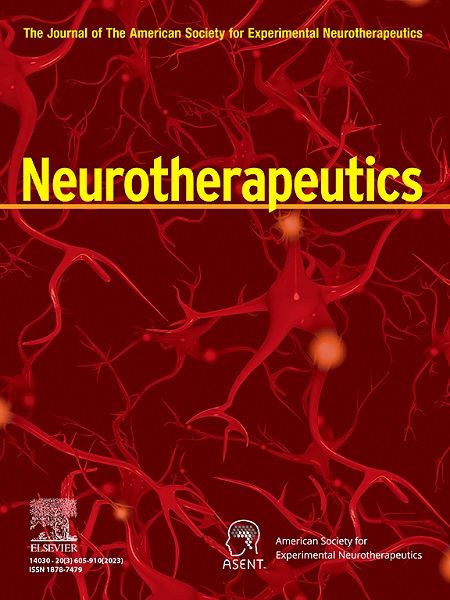孟鲁司特缓解帕金森病61行模型的神经炎症和改善运动功能:一项探索性研究
IF 6.9
2区 医学
Q1 CLINICAL NEUROLOGY
引用次数: 0
摘要
帕金森病(PD)是一种全球性的高负担神经退行性运动障碍。关于其确切病因的不确定性一直阻碍着治疗方法的发展。由于小胶质细胞,大脑的免疫细胞,被怀疑通过引发神经炎症来促进神经退行性变,现有的抗炎药物可能潜在地作为PD的疾病改善治疗方法。在这里,我们在α-突触核蛋白转基因小鼠模型(Line 61)中评估了孟鲁司特(一种白三烯受体拮抗剂和抗炎药)对早发性/遗传性PD的运动症状和神经病理学的影响。两周龄雄性Line 61小鼠和非转基因幼鼠每天口服10 mg/kg孟鲁司特或药,持续10周。通过行为测试评估运动功能。脑组织通过无偏倚转录组学、生化和组织学分析各种参数,包括小胶质细胞和炎症介质。孟鲁司特治疗后,Line 61小鼠的光束行走性能明显改善。孟鲁司特治疗组的纹状体和小脑显示小胶质细胞向更小但更分枝的外观变化。转录组学分析显示,在孟鲁司特治疗的动物纹状体中,NFκB上游的丝氨酸/苏氨酸激酶SGK1 (PD的已知靶点)是下调最多的基因。这种下调与活化的i - κ b激酶纹状体蛋白水平降低相关,表明孟鲁司特治疗后nf - κ b通路活性降低。因此,口服孟鲁司特可能对帕金森病的治疗有希望,对运动协调和平衡有特定的影响。本文章由计算机程序翻译,如有差异,请以英文原文为准。
Montelukast alleviates neuroinflammation and improves motor functions in the line 61 model of Parkinson's disease: An exploratory study
Parkinson's disease (PD) is a neurodegenerative movement disorder of high global burden. Uncertainties regarding its exact etiology have been hindering the development of curative therapies. As microglia, the brain's immune cells, are suspected to contribute to neurodegeneration by instigating neuroinflammation, existing anti-inflammatory agents could potentially serve as disease-modifying treatments for PD. Here we evaluated the impact of montelukast, a leukotriene receptor antagonist and anti-inflammatory drug, on motor symptoms and neuropathology in an α-synuclein transgenic mouse model (Line 61) for early onset/genetic PD. Two -weeks -old male Line 61 mice and non-transgenic littermates received daily 10 mg/kg montelukast or vehicle orally for 10 weeks. Motor functions were assessed through behavioral tests. Brain tissue was analyzed via unbiased transcriptomics, biochemically, and histologically for various parameters, including microglial and inflammation mediators. Upon montelukast treatment, Line 61 mice significantly improved their beam walk performance compared to vehicle -treated mice. The striatum and cerebellum of the montelukast -treated group showed microglial changes toward a smaller but more ramified appearance. Transcriptomics analysis revealed SGK1, a serine/threonine kinase upstream of NFκB and known target in PD, as the most downregulated gene in the striatum of montelukast -treated animals. This downregulation correlated with reduced striatal protein levels of activated IκB kinase, suggesting a reduced NFκB pathway activity upon montelukast treatment. Thus, oral montelukast administration might be promising for the management of PD, with specific effects on motor coordination and balance.
求助全文
通过发布文献求助,成功后即可免费获取论文全文。
去求助
来源期刊

Neurotherapeutics
医学-神经科学
CiteScore
11.00
自引率
3.50%
发文量
154
审稿时长
6-12 weeks
期刊介绍:
Neurotherapeutics® is the journal of the American Society for Experimental Neurotherapeutics (ASENT). Each issue provides critical reviews of an important topic relating to the treatment of neurological disorders written by international authorities.
The Journal also publishes original research articles in translational neuroscience including descriptions of cutting edge therapies that cross disciplinary lines and represent important contributions to neurotherapeutics for medical practitioners and other researchers in the field.
Neurotherapeutics ® delivers a multidisciplinary perspective on the frontiers of translational neuroscience, provides perspectives on current research and practice, and covers social and ethical as well as scientific issues.
 求助内容:
求助内容: 应助结果提醒方式:
应助结果提醒方式:


